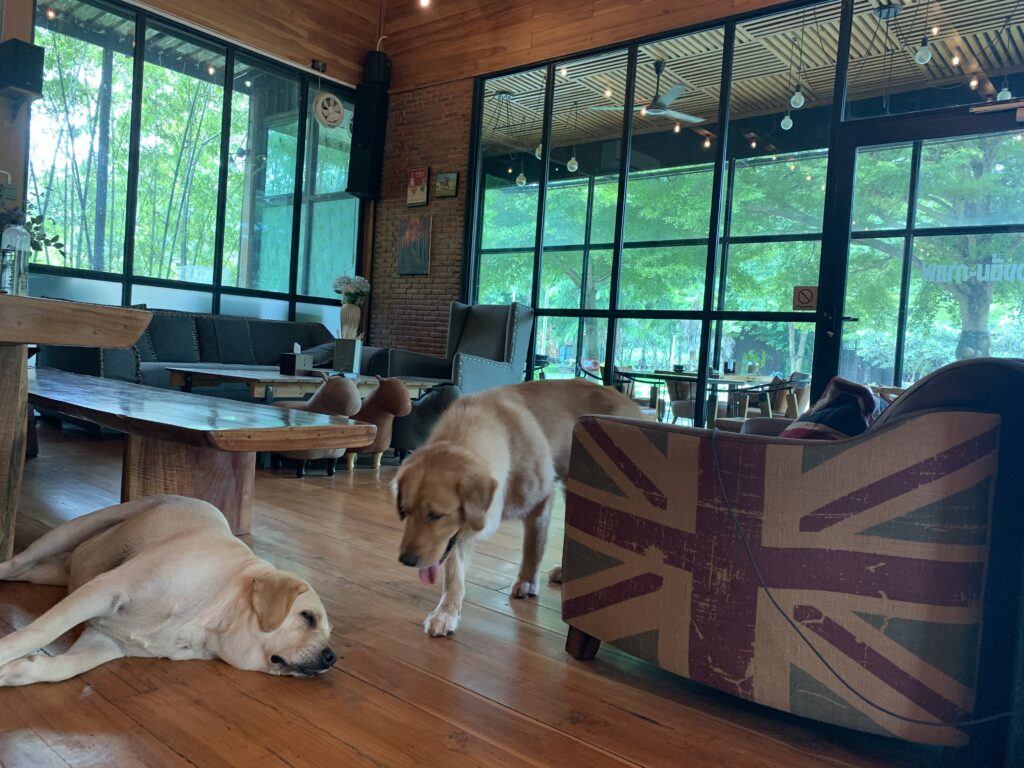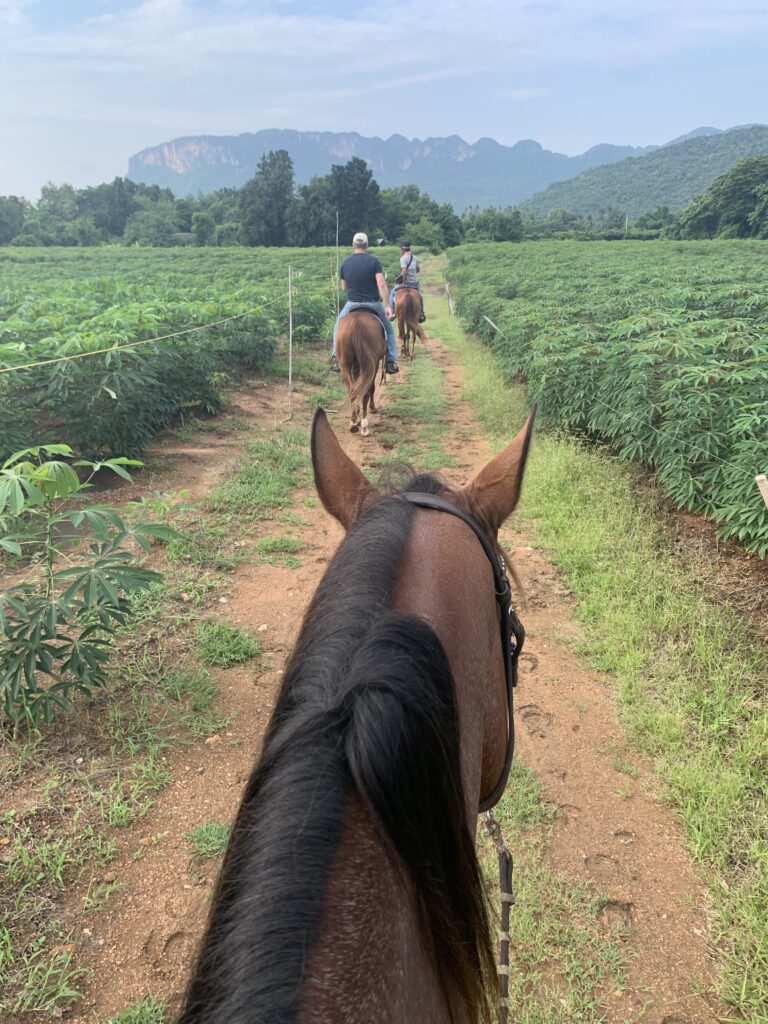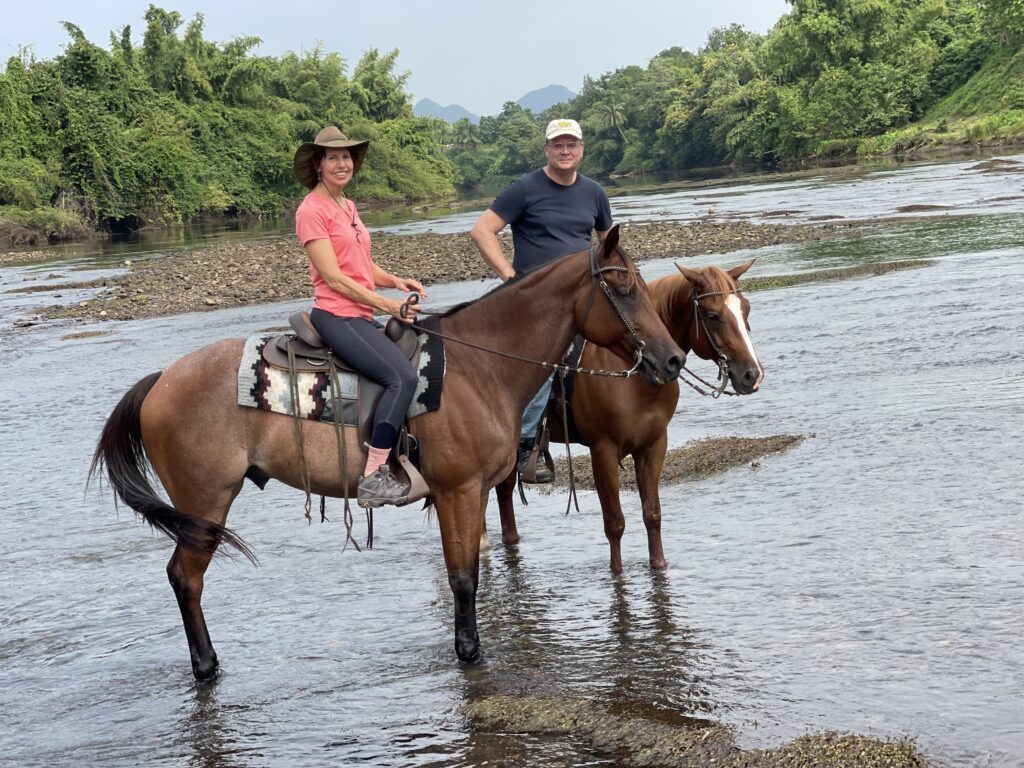As our fall break approached, I knew I wanted to spend some time in nature. I also missed the presence of horses in my life. Fortunately, a friend recommended a perfect option: Chaowanat Horse Farm, a picturesque retreat located along a river and surrounded by low mountains, just a 3-hour drive away.

This was the view from our room. My plan was to sit on the deck all day with a book and a beer, but there were no chairs (or beers). The wooden bench that surrounded the deck was crawling with thousands of massive orange ants. Not very inviting.

The property featured a cozy restaurant and coffee shop, a massive garden, the stables, an arena, and plenty of green spaces. The owner was out of town, so his son checked us in to our room. I told him we wanted to plan some excursions, and he suggested it would be nearly impossible to get a taxi to pick us up. That was discouraging. We had hired a driver to take us to the farm, and after he left, we realized we were about 40 minutes from Kanchaburi town.
We booked a horse ride for the next morning but discovered we couldn’t go tubing on the river because the water level was too low. I was getting a little cranky.









Tony and I lounged around the restaurant for a bit, ate lunch, went for a walk, checked out the horses, and then wandered back to the room. “I know what I need from this break, and I’m afraid I’m not going to get it,” I told him. I didn’t want to sit on the bed in an over airconditioned room for four days.
The next morning we met our cowboy guide, Ek, and our horses. Tony rode a stallion named Diamond, and I rode a gelding named Spicy. Ek told us they were American Quarterhorses. Something in my head shifted the minute I landed in the saddle. Horse energy gets me every time, and despite his name, Spicy was a sweet and gentle soul.
Ek led us out of the farm along muddy paths throughout the countryside. To be honest, Tony and I thought we were seeing marijuana plants. Thailand recently legalized weed, so we innocently assumed it was a cash crop. It’s clearly not an area of expertise for us. Ek clarified that the plants were actually cassava, one of Thailand’s major export products. If you’re as clueless about cassava as I was, check this out.

As we passed this herd of cattle, Ek laughed about how horses and cows in Thailand get spooked by each other. Ek had traveled to Texas once and appreciated that cowboy lifestyle. “No cutting here,” he laughed, referring to the use of horses to round up individual cows in a herd. Side note: How much do you love the floppy ears on these cows?

We emerged in a big meadow at one point, where Ek dismounted and hunkered down behind a clump of flowers.
“Go!” he shouted to us.
“Go where?” we asked each other.
We aimlessly wandered around until he finally got back on his horse and took the lead. A similar thing happened when we reached the river. “Go!” he shouted.
“Are we crossing the river?” I asked.
“No cross. Just go,” he said.
We clomped around in the shallow water, let the horses take a drink, and watched a little boy from the farm splash around. It was confusing.
Later, we realized Ek was taking photos and video of us. We were hopelessly noncompliant models. In retrospect, it was kind of hilarious. There are videos where we are just sitting still, staring at him. I’m sure he expected us to prance around a bit and exhibit some level of drama. Lesson learned.


As we were riding back to the farm, I said to Tony, “You know how I said I wasn’t getting what I needed from this break? Well, I’m getting it now!” I’m sure he was relieved.
After spending the next day touring some nearby sights, we headed back to Bangkok a day early, not because of any fault with the horse farm. It was bad planning on my part not to realize how isolated we would be.
The experience of travel can feel like one rookie mistake after another, even when you’ve been wandering the earth as long as we have. Each new place poses a learning curve. Fortunately, living abroad provides opportunities for a re-do. We definitely want to revisit this area of Thailand, but next time we’ll drive ourselves, stay somewhere with comfortable outdoor seating, and spend a day back at Chaowanat for a little horse time.

By the way, after checking out Chaonawat’s Instagram, I now realize we dropped the ball. We should have dressed up for lovely shots like this. Oh well, next time.


















